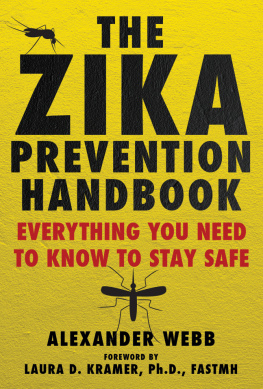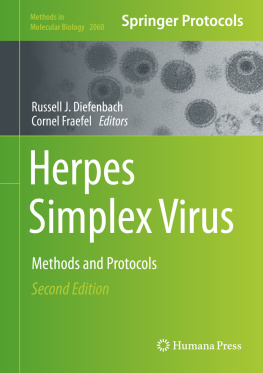Gary Kobinger - Zika Virus: Methods and Protocols
Here you can read online Gary Kobinger - Zika Virus: Methods and Protocols full text of the book (entire story) in english for free. Download pdf and epub, get meaning, cover and reviews about this ebook. year: 2020, publisher: Human, genre: Home and family. Description of the work, (preface) as well as reviews are available. Best literature library LitArk.com created for fans of good reading and offers a wide selection of genres:
Romance novel
Science fiction
Adventure
Detective
Science
History
Home and family
Prose
Art
Politics
Computer
Non-fiction
Religion
Business
Children
Humor
Choose a favorite category and find really read worthwhile books. Enjoy immersion in the world of imagination, feel the emotions of the characters or learn something new for yourself, make an fascinating discovery.
- Book:Zika Virus: Methods and Protocols
- Author:
- Publisher:Human
- Genre:
- Year:2020
- Rating:3 / 5
- Favourites:Add to favourites
- Your mark:
- 60
- 1
- 2
- 3
- 4
- 5
Zika Virus: Methods and Protocols: summary, description and annotation
We offer to read an annotation, description, summary or preface (depends on what the author of the book "Zika Virus: Methods and Protocols" wrote himself). If you haven't found the necessary information about the book — write in the comments, we will try to find it.
Zika Virus: Methods and Protocols — read online for free the complete book (whole text) full work
Below is the text of the book, divided by pages. System saving the place of the last page read, allows you to conveniently read the book "Zika Virus: Methods and Protocols" online for free, without having to search again every time where you left off. Put a bookmark, and you can go to the page where you finished reading at any time.
Font size:
Interval:
Bookmark:

For further volumes: http://www.springer.com/series/7651 For over 35 years, biological scientists have come to rely on the research protocols and methodologies in the critically acclaimed Methods in Molecular Biology series. The series was the first to introduce the step-by-step protocols approach that has become the standard in all biomedical protocol publishing. Each protocol is provided in readily-reproducible step-bystep fashion, opening with an introductory overview, a list of the materials and reagents needed to complete the experiment, and followed by a detailed procedure that is supported with a helpful notes section offering tips and tricks of the trade as well as troubleshooting advice. These hallmark features were introduced by series editor Dr. John Walker and constitute the key ingredient in each and every volume of the Methods in Molecular Biology series. Tested and trusted, comprehensive and reliable, all protocols from the series are indexed in PubMed.
For over 35 years, biological scientists have come to rely on the research protocols and methodologies in the critically acclaimedMethods in Molecular Biologyseries. The series was the first to introduce the step-by-step protocols approach that has become the standard in all biomedical protocol publishing. Each protocol is provided in readily-reproducible step-by-step fashion, opening with an introductory overview, a list of the materials and reagents needed to complete the experiment, and followed by a detailed procedure that is supported with a helpful notes section offering tips and tricks of the trade as well as troubleshooting advice. These hallmark features were introduced by series editor Dr. John Walker and constitute the key ingredient in each and every volume of theMethods in Molecular Biologyseries. Tested and trusted, comprehensive and reliable, all protocols from the series are indexed in PubMed.

Cover Caption: Cover image courtesy of Jordi Gouilly, a PhD student in the Jabrane-Ferrat Laboratory
This Humana imprint is published by the registered company Springer Science+Business Media, LLC, part of Springer Nature.
The registered company address is: 1 New York Plaza, New York, NY 10004, U.S.A.
Zika virus (ZIKV) is a vector-borne flavivirus spread by theAedesspecies of mosquitos that was first identified in a sentinel monkey in Uganda in 1947. ZIKV generally causes a mild febrile illness and its circulation and spread from Africa to Asia over 60 years culminated in its emergence in South and Central America in 2015. There, ZIKV caused a Public Health Emergency of International Concern in 2016 as declared by the World Health Organization (WHO) due to severe pathology in newborns, including brain damage and microcephaly (often associated with ocular abnormalities).
ZIKV-induced congenital malformations were well documented starting in 2015 and while it may represent the most severe disease phenotype, there is a concern that less severe infections may also result in subtler, long-term cognitive and functional disorders, as described for cytomegalovirus. An initial, very limited, exploration of ZIKV-induced pathophysiology between 1947 and 2015 led to the belief that this virus was of little concern when instead its spread and evolution brought dire consequences to large populations of entire countries in the Americas. Importantly, the past few years have contributed substantial knowledge to our understanding of this pathogen, how it can induce consequential clinical disease and life-long damages. This knowledge was and continues to be of critical value to the development and evaluation of experimental therapeutic and preventive interventions against ZIKV infection and/or disease. A high number of neurological clinical manifestations have been reported in infected adults such as GuillainBarr syndrome, as well as encephalitis, meningitis, myelitis, and seizure. While the mechanisms underlying these neurological disorders have yet to be fully elucidated, a wealth of knowledge on the virus, its pathogenesis, host response, animal models, and potential interventions have accumulated in recent years. Indeed, the amount of knowledge accumulated on ZIKV has grown exponentially since 2015, bringing forward the most cutting-edge technologies to support studies exploring a plethora of different scientific hypotheses and concepts. This book assembles scientific protocols developed and utilized by leading scientists in the field of virology and specifically on ZIKV. These protocols are invaluable to further our understanding of this pathogen and how to mitigate its presence. They are assembled to facilitate studies on several aspects of this virus that could contribute added knowledge and therefore bring meaningful benefits to the detection, diagnosis, management, treatment, and prevention of this infection and possibly to one day see its eradication.
The first aim of this volume is to highlight the state of our understanding of Zika virus, its pathogenesis, and the limited molecular techniques we had at our disposal at the beginning of the outbreak in the Americas in 2015 with the introductory chapter. Then, we sought to introduce the gold standard techniques in virus isolation, purification, and the various means of titrating the virus. Our final aim of the volume was to highlight how some of the gold standard assays have been advanced in recent years through the development of modified molecular techniques. Not only can these improved diagnostic, animal model, and therapeutic techniques be used in the study of Zika virus, but they can also be adapted for the study of a plethora of other viruses.
Font size:
Interval:
Bookmark:
Similar books «Zika Virus: Methods and Protocols»
Look at similar books to Zika Virus: Methods and Protocols. We have selected literature similar in name and meaning in the hope of providing readers with more options to find new, interesting, not yet read works.
Discussion, reviews of the book Zika Virus: Methods and Protocols and just readers' own opinions. Leave your comments, write what you think about the work, its meaning or the main characters. Specify what exactly you liked and what you didn't like, and why you think so.











